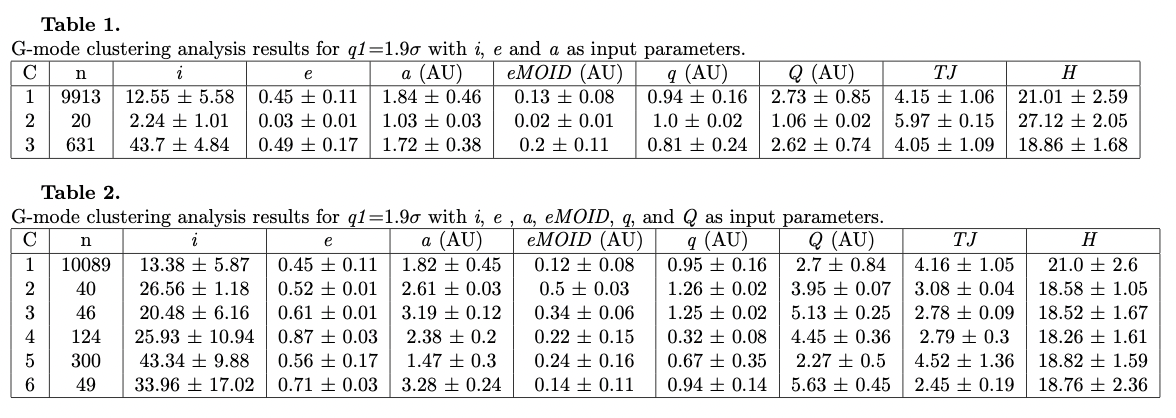Statistical clustering analysis of NEOs using their orbital parameters to find correlations with spectral classes
- 1INAF – Osservatorio Astronomico di Roma, Via Frascati 33, 00078 Monte Porzio Catone, Italy (prasanna.deshapriya@inaf.it)
- 2LESIA, Observatoire de Paris, Université PSL, CNRS, Université de Paris, Sorbonne Université, 5 place Jules Janssen, 92195 Meudon, France
- 3Agenzia Spaziale Italiana, Via del Politecnico 1, 00133, Rome, Italy
- Introduction
The study of near-Earth objects (NEOs) is crucial to better understand the origin, formation and the evolution of the solar system. In particular, compositional, morphological and orbital characterisation of NEOs sheds light on the delivery of water and organics [1,2,3] to the prebiotic Earth, while ironically, some NEOs could be potential hazards for life on Earth [4], as it has been witnessed in the past during impacts. Furthermore, these objects are also of interest for the future of humankind, for they could be useful as vital resources during interplanetary travel. Given this context, we apply the G-mode multivariate statistical clustering method [5,6,7] on the orbital parameters of the currently available NEOs population, to probe potential associations with their spectral classification [8,9,10].
- Data and methods
We apply the G-Mode multivariate statistical clustering analysis to selected orbital elements of NEOs to determine any dynamical clustering of objects. Once the clusters of objects are found, we proceed to investigate whether they have any correlations with spectral classes. The G-mode method leads to an automatic statistical clustering of a sample containing N objects (NEOs in this case), described by M variables (orbital elements) with the only control imposed by the user being the confidence level q1, expressed in terms of σ.
Our sample consists of 10669 NEOs belonging to the dynamical groups Atiras, Atens, Apollos and Amors, available from the Minor Planet Center, filtered based on their orbital uncertainty (excluding those with an uncertainty parameter > 4). Our input parameters to the G-mode method are twofold. First, we use three variables: inclination (i), eccentricity (e) and semi-major axis (a) of the orbit as these are the main three parameters that define an orbit around the Sun. Secondly, we include three pseudo-parameters: mean orbital intersection distance with respect to the Earth (eMOID), perihelion distance (q) and aphelion distance (Q) of the orbit, in addition to the aforementioned three parameters, thus using six variables.
- Preliminary results
Using i, e and a of the NEOs in our sample as inputs for G-mode, we obtain three clusters of NEOs at q1=1.9σ (with an accurate classification probability of 94.26%). The mean parameter values of each cluster with the median absolute deviation are given in Table 1. We have also reported some other parameters of interest, which include, Tisserand parameter with respect to Jupiter (TJ) and the absolute magnitude H. At this criterion, the vast majority of objects are clustered in the cluster #1. The cluster #2 with only 20 objects, appears interesting, as it is constrained by low-inclined, quasi-circular Earth-like orbits. The objects of the final cluster #3 are constrained by their relatively larger inclinations.
We next used six variables: i, e, a, eMOID, q and Q as inputs for G-mode, while still holding q1 fixed at 1.9σ, in which case six clusters are found as reported in Table 2. Among the reported clusters, clusters #3,4 and 6 are of particular interest, for they could be associated with Jupiter-family cometary nuclei (2 < TJ < 3) as per their Tisserand parameter with respect to Jupiter. As such, the objects in these three clusters could potentially be extinct cometary nuclei. Interestingly, these clusters also have relatively higher eccentricities. We have checked available taxonomic classifications of NEOs [11,12,13] in the literature to get an insight into the composition of the objects found in our G-Mode clusters. Although taxonomic classifications are not available for the majority of members in the clusters, we find that (i) cluster #3 contains 4 C-type objects, (ii) cluster #4 contains 1 C-type, 2 D-type, 1 L-type, 5 S-type and 1 X-type objects, (iii) cluster #5 contains 1 B-type, 1 C-type, 1 T-type and 1 X-type objects. Apart from the S-type objects, the others usually have dark and red spectra indicative of primitive origin, which does not reject a cometary composition.
We will augment this on-going study with more data and final results will be presented and discussed.

- Acknowledgements
We acknowledge the financial support from Agenzia Spaziale Italiana (ASI, contract No. 2017-37-H.0 CUP F82F17000630005). We also acknowledge funding from the European Union’s Horizon 2020 research and innovation programme under grant agreement No. 870403.
References
[1] Marty, B., Guillaume, A. et al. 2016, Earth and Planetary Science Letters, Volume 441, Pages 91-102
[2] Altwegg, K, Balsiger, H, Bar-Nun, A. et al. 2015, Science, Vol. 347, Issue 6220, 1261952
[3] Ehrenfreund, P. & Sephton 2006, Faraday Discuss., The Royal Society of Chemistry, 133, 277-288
[4]Perna, D., Barucci M. A., Fulchignoni M. 2013, Astronomy and Astrophysics Review, Vol. 21,65
[5] Barucci, M.A., Capria, M.T., Coradini, A. et al. 1987, Icarus 72, 304
[6] Gavrishin, A. I., et al. 1992, Earth, Moon and Planets, 59, 141-152
[7] Barucci, M.A., Belskaya, I., Fulchignoni, M. et al. 2005, AJ 130, 1291
[8] Bus, S. J., & Binzel, R.P. 2002, Icarus 158, 146
[9] DeMeo, F. E., Binzel, R. P., Slivan, S. M. & Bus, S. J. 2009, Icarus, 202, 160-180
[10] DeMeo, F. E., Alexander, C. M. O., Walsh, K. J.et al. 2015, Asteroids IV, 13-41
[11] Perna, D., Barucci, M.A. et al. 2018, Planetary and Space Science, 157, 82-95
[12]Devogèle, M., Moskovitz, N. et al. 2019, The Astronomical Journal, American Astronomical Society, 158, 196
[13] Ieva, S., Dotto, E. et al. 2020, A&A, 644, A23
How to cite: Deshapriya, J. D. P., Perna, D., Bott, N., Hasselmann, P. H., Giunta, A., Dotto, E., Perozzi, E., Ieva, S., and Mazzotta Epifani, E.: Statistical clustering analysis of NEOs using their orbital parameters to find correlations with spectral classes, European Planetary Science Congress 2021, online, 13–24 Sep 2021, EPSC2021-614, https://doi.org/10.5194/epsc2021-614, 2021.

